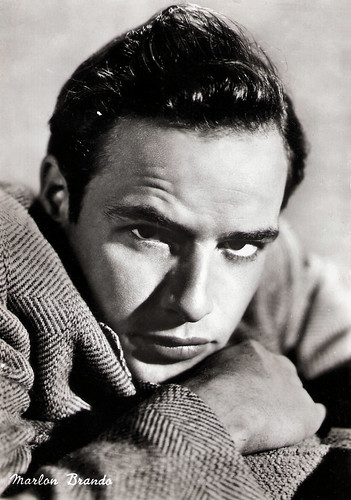
Italian postcard by Bromofoto, Milano, no. 565.

Italian postcard by B.F.F. Edit., no. 2980. Photo: Columbia / C.E.I.A.D.

Italian postcard by Bromofoto, Milano.
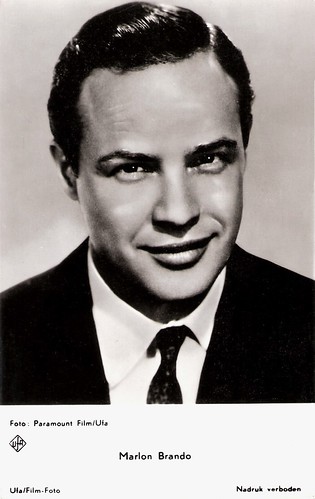
Dutch postcard by Gebr. Spanjersberg N.V., Rotterdam, no. 4992. Photo: Paramount Film / Ufa.
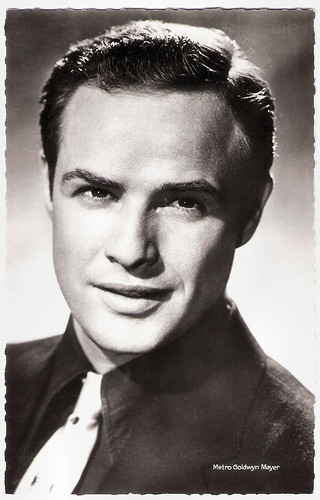
French postcard by Editions du Globe, no. 535. Photo: Metro-Goldwyn-Mayer. Publicity still for Guys and Dolls (Joseph L. Mankiewicz, 1955).
Stella! Stella!
Marlon Brando was born in 1924, in Omaha, Nebraska, to Marlon Brando, Sr., a pesticide and chemical feed manufacturer, and his artistically inclined wife, the former Dorothy Julia Pennebaker. Brando had two older sisters, Jocelyn Brando (1919–2005) and Frances (1922–1994). Jocelyn was the first to pursue an acting career, going to study at the American Academy of Dramatic Art in New York City. She appeared on Broadway, then in films and television. Marlon had been held back a year in school and was later expelled from Libertyville High School for riding his motorcycle through the corridors.
In 1943, he decided to follow his sister to New York. Brando enrolled in Erwin Piscator's Dramatic Workshop at New York's New School, and was mentored by Stella Adler, a member of a famous Yiddish Theatre acting family. Adler helped introduce to the New York stage the 'emotional memory' technique of Russian theatrical actor, director and impresario Konstantin Stanislavski, whose motto was "Think of your own experiences and use them truthfully." This technique encouraged the actor to explore his own feelings and past experiences to fully realise the character being portrayed. Brando's remarkable insight and sense of realism were evident early on. In 1944, he made it to Broadway in the bittersweet drama I Remember Mama, playing the son of Mady Christians. New York Drama Critics voted him 'Most Promising Young Actor' for his role as an anguished veteran in Truckline Café, although the play was a commercial failure. His breakthrough was the role of Stanley Kowalski in Tennessee Williams's 1947 play A Streetcar Named Desire, directed by Elia Kazan. Brando based his portrayal of Kowalski on the boxer Rocky Graziano, whom he had studied at a local gymnasium.
Brando's first screen role was the bitter paraplegic war veteran in The Men (Fred Zinnemann, 1950). In typical Method fashion, he spent a month in an actual veteran's hospital in preparation for the role. Brando rose to fame when he repeated the role of Stanley Kowalski in the film A Streetcar Named Desire (Elia Kazan, 1951). The role is regarded as one of Brando's greatest. The reception of Brando's performance was so positive that Brando quickly became a male sex symbol in Hollywood. The role earned him his first Academy Award nomination but lost despite Oscars for his co-stars, Vivien Leigh, Karl Malden, and Kim Hunter.
Brando was also Oscar-nominated the next year for Viva Zapata! (Elia Kazan, 1952), a fictionalised account of the life of Mexican revolutionary Emiliano Zapata. His next film, Julius Caesar (Joseph L. Mankiewicz, 1953), received highly favourable reviews. Brando portrayed Mark Antony opposite John Gielgud. Another iconic portrayal is the rebel motorcycle gang leader Johnny Strabler in The Wild One (Laslo Benedek, 1953), riding his own Triumph Thunderbird 6T motorcycle. His rowdy portrayal is considered to be one of the most famous images in pop culture. After the movie's release, the sales of leather jackets and blue jeans skyrocketed.
Then followed his Academy Award-winning performance as Terry Malloy in On the Waterfront (Elia Kazan, 1954), a crime drama about union violence and corruption among longshoremen. As the decade continued, Brando remained a top box office draw but critics felt his performances were half-hearted, lacking the intensity and commitment found in his earlier work. He co-starred with Jean Simmons in Désirée (Henry Koster, 1954) and the musical Guys and Dolls (Joseph L. Mankiewicz, 1955). In Sayonara (Joshua Logan, 1957) he appeared as a United States Air Force Major Lloyd Gruver. The film was controversial due to openly discussing interracial marriage but proved a great success, earning 10 Academy Award nominations, with Brando being nominated for Best Actor. The following year, Brando appeared opposite Montgomery Clift as the sympathetic Nazi officer Christian Diestl in The Young Lions (Edward Dmytryk, 1958), dyeing his hair blonde and assuming a German accent for the role, which he later admitted was not convincing. The film was the last hit Brando would have for more than a decade.
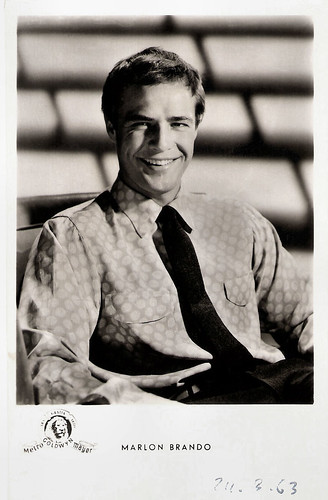
German postcard by Kunst und Bild, no. L 969. Photo: Metro-Goldwyn-Mayer. Publicity still for Julius Caesar (Joseph L. Mankiewicz, 1953).

Spanish postcard, no. 2656. Marlon Brando as Napoleon Bonaparte in Désirée (Henry Koster, 1954).

Belgian postcard, no. 348. Photo: Marlon Brando and Jean Simmons in Désirée (Henry Koster, 1954).
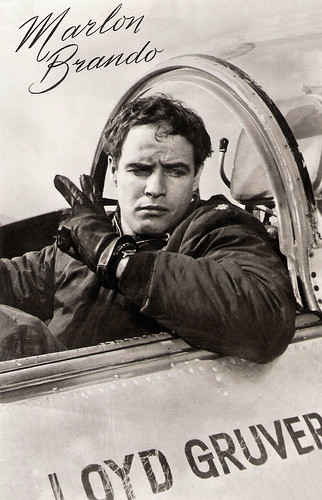
Dutch postcard by Uitgeverij Takken, Utrecht, no. 3730. Photo: Warner Bros. Publicity still for Sayonara (Joshua Logan, 1957).

Dutch postcard by Uitgeverij Takken, Utrecht, no. 3734. Photo: Warner Bros. Publicity still for Sayonara (Joshua Logan, 1957) with Miiko Taka.
The horror! The horror!
Marlo Brando directed and starred in the cult Western One-Eyed Jacks (1961), a critical and commercial flop. After both Stanley Kubrick and Sam Peckinpah had walked off the project, Brando grabbed the directorial reins. He never again directed another film. During the 1960s, he delivered a series of box-office failures, beginning with the film adaptation of the novel Mutiny on the Bounty (Lewis Milestone, 1962). Brando's revulsion with the film industry reportedly boiled over on the set of this film. His diminishing box-office stature, combined with his increasingly temperamental behaviour, made him a target of scorn for the first time in his career. The downward spiral continued for some years. Interesting was Reflections in a Golden Eye (John Huston, 1967), an adaptation of a Carson McCullers novel in which he portrayed a closeted and repressed gay army officer. He also did influential performances in The Chase (Arthur Penn, 1966), the Italian-French anti-colonialist drama Queimada/Burn! (Gillo Pontecorvo, 1970) and the British horror film The Nightcomers (Michael Winner, 1971). However, the films were financial flops and Hollywood began to perceive him as a bad and unnecessary risk.
By the dawn of the 1970s, Brando was considered 'unbankable' and critics were becoming increasingly dismissive of his work. Brando's performance as Don Vito Corleone in The Godfather (1972), Francis Ford Coppola's adaptation of Mario Puzo's 1969 bestseller, was a career turning point. The Godfather was then one of the most commercially successful films of all time. The film put him back in the Top Ten and won him his second Best Actor Oscar. He followed The Godfather with Ultimo Tango a Parigi/Last Tango in Paris (Bernardo Bertolucci, 1972) opposite Maria Schneider. The film features several intense, graphic scenes involving Brando, and the controversial film was another hit.
Brando took a four-year hiatus before appearing in the Western The Missouri Breaks (Arthur Penn, 1976) with Jack Nicholson. Then he made a rare appearance on television in the miniseries Roots: The Next Generations (1979), for which he won an Emmy award. In this period, he was content with being a highly paid character actor in glorified cameo roles, such as in Superman (Richard Donner, 1978) and The Formula (John G. Avildsen, 1980), before taking a nine-year break from motion pictures. However, he also did his controversial performance as Colonel Kurtz in the Vietnam epic Apocalypse Now (Francis Coppola, 1979). The film earned critical acclaim, as did Brando's performance. Marlon's whispering of Kurtz's final words "The horror! The horror!", has become particularly famous. It was his last great performance.
Years later though, he did receive an eighth and final Oscar nomination for his supporting role as an attorney in the anti-Apartheid drama A Dry White Season (Euzhan Palcy, 1989) after coming out of a near-decade-long retirement. Brando was an activist with deep political convictions, supporting many causes, notably the African-American Civil Rights Movement and various American Indian Movements. He made another comeback in the Johnny Depp romantic drama Don Juan DeMarco (Jeremy Leven, 1994), which co-starred Faye Dunaway as his wife.
Brando owned a private island off the Pacific coast, the Polynesian atoll known as Tetiaroa, from 1966 until his death in 2004. He was married three times. First to actress Anna Kashfi in 1957. They divorced in 1959. In 1960, Brando married Movita Castaneda, a Mexican-American actress seven years his senior; the marriage was annulled in 1968. Tahitian actress Tarita Teriipaia, who played Brando's love interest in Mutiny on the Bounty, became his third wife. She was 18 years younger than Brando. They divorced in 1972. Brando had a long-term relationship with his housekeeper Maria Christina Ruiz, by whom he had three children. In 2004, Marlon Brando died of respiratory failure in Westwood, California, at age 80. He left behind 14 children (two of his children, Cheyenne and Dylan Brando, had predeceased him), as well as over 30 grandchildren. The last words are for Jason Ankeny at AllMovie: "Marlon Brando was quite simply one of the most celebrated and influential screen and stage actors of the postwar era; he rewrote the rules of performing, and nothing was ever the same again. Brooding, lusty, and intense, his greatest contribution was popularizing Method acting, a highly interpretive performance style which brought unforeseen dimensions of power and depth to the craft. (...) He is one of the screen's greatest enigmas, and there will never be another quite like him."

Italian postcard by Rotalcolor / Rotalfoto.

German postcard by Ufa. Photo: Dieter E. Schmidt. An incredibly coloured and polished version of the American star. The chromatic blond seems to be from the time Brando played a Nazi officer in The Young Lions (Edward Dmytryk, 1958).

Italian postcard by CVB Publishers, no. 56772. Photo: Sam Shaw. Caption: Marlon Brando, New York City, 1960.

French postcard by EDUG, no. 133. Sent by mail in 1961. Photo: Bud Fraker. Publicity still for One-Eyed Jacks (Marlon Brando, 1961).

British postcard by Star-Graphics, no. S 91. Photo: Al Pacino and Marlon Brando in The Godfather (Francis Ford Coppola, 1972).
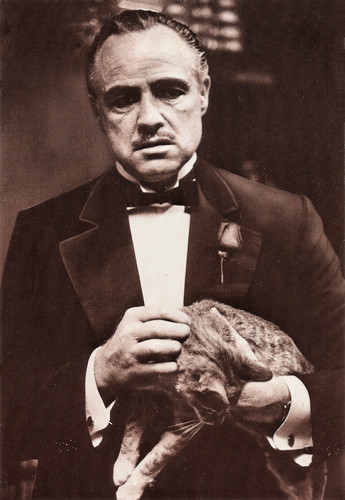
American postcard by Classico San Francisco, no. 136-183. Photo: The Ludlow Collection. Publicity still for The Godfather (Francis Ford Coppola, 1972).
Sources: Jason Ankeny (AllMovie), Jon C. Hopwood (IMDb), Wikipedia and IMDb.
This post was last updated on 30 July 2023.
No comments:
Post a Comment